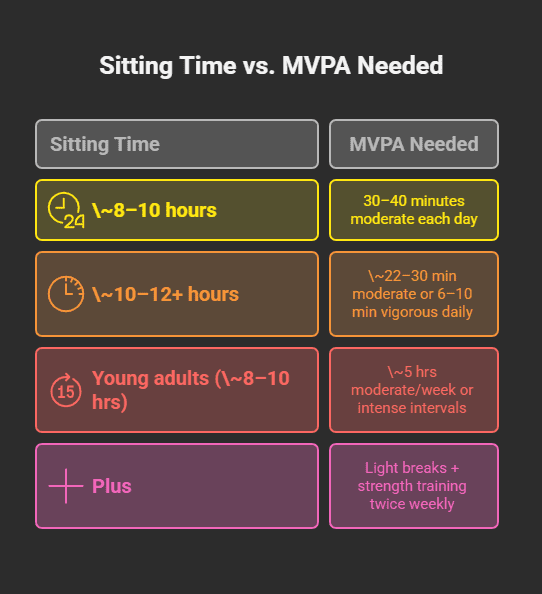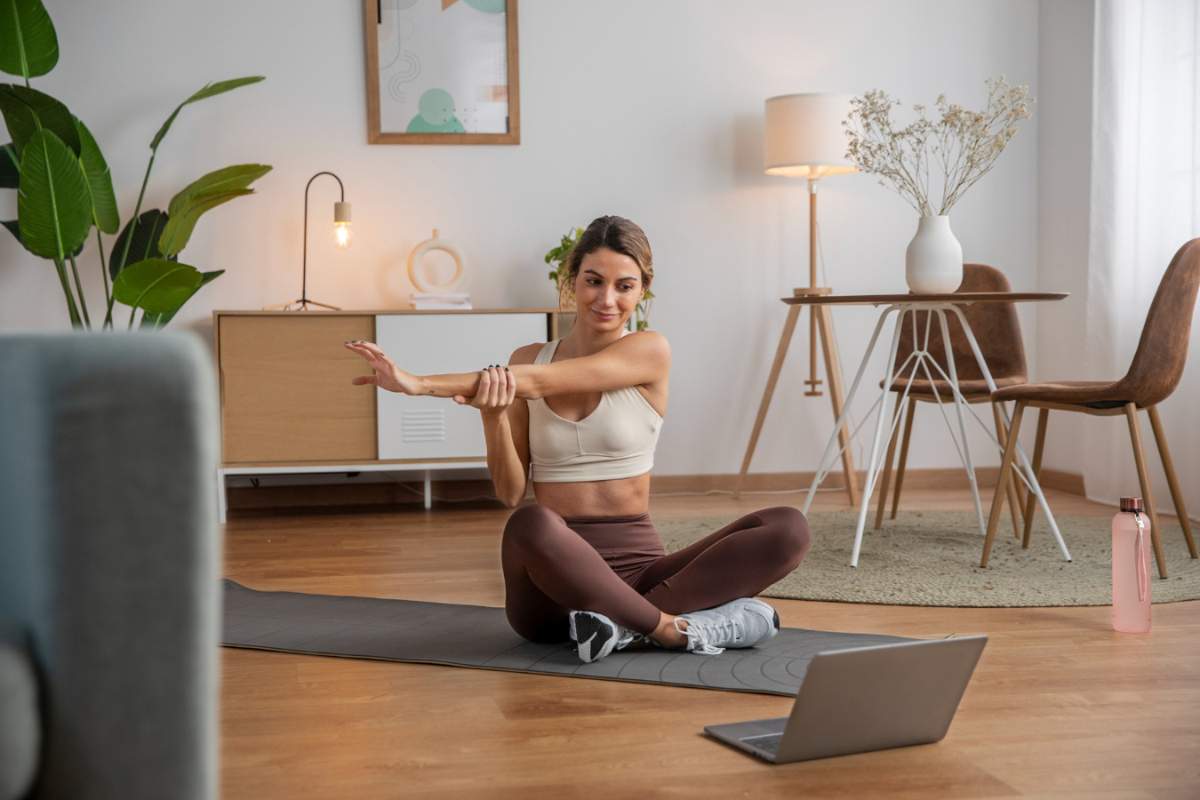We all know that “sitting is the new smoking.” Sounds good, right? But the truth is that there is more truth there than we want to admit. Think about it: long commutes, desk jobs, and Netflix binges. Every day. It’s like putting your life on hold.
Your health suffers when you sit still for eight hours or more. It’s not just feeling stiff; it’s a real danger. If you don’t exercise much, your risk of dying young goes up, just like if you smoke or are overweight. Moving around more and sitting less? That’s the answer.
Okay, but what if you do exercise?
Here’s the thing. There is still some hope. It makes me feel strong.
This is what a lot of studies that use fitness tracker data show: doing moderate to vigorous exercise for 30 to 40 minutes a day can cancel out the risk of sitting for about 10 hours. Moderate to strong? Think of things that get your heart and breath going, like fast walks, cycling, gardening, dancing, and more.
And yes, gardening is one of them. Who would have thought that cutting back roses would save lives?
If you look more closely, you’ll see that 20 to 25 minutes a day can do the same thing, especially for people over 50. About 22 minutes of that Mid-level Intensity movement will get rid of the risks of sitting, even if you sit for more than 12 hours.
So, is it 20 or 40 minutes? It depends. Some people study different things. But one thing is clear: the answer is to move around regularly, at least moderately to vigorously.
The intensity of conversation: light, moderate, vigorous
Let’s break it down:
- Light activity: standing breaks, leisurely walking, light chores. Not bad, but only helpful if you’re super sedentary. Swapping even 30–60 minutes of sitting for gentle movement helps, but it isn’t enough alone.
- Moderate activity: brisk walking (~2.5 mph), casual cycling, doubles tennis. This is your bread and butter.
- Vigorous activity: running, fast cycling, swimming laps, jumping rope. Believe it or not, one study suggests that just 6 minutes per day of vigorous movement can offset most of that sitting-related mortality risk. Six minutes. Wow, huh?
In practical terms, don’t want a long workout session every day? Try a short high‑intensity burst (interval sprints, jump‑ropes, stair climbs). Or go longer and steadier. Your call.
What major health bodies recommend
International & national guidelines
- The World Health Organization (WHO) endorses 150–300 minutes per week of moderate activity or 75–150 minutes per week of vigorous movement. That breaks down to about 22–43 minutes daily of moderate effort.
- The American Heart Association (AHA) aligns: 150 minutes of moderate or 75 minutes of vigorous weekly activity, plus strength training twice a week. They also stress that even light movements, standing, small walks, provide benefits when breaking up sitting.
- The UK NHS echoes the 150-minute moderate/week guidance, adding that breaking up long sitting bouts, even with light activity, is important.
Practical translation
- Sitting ~10 hrs/day? Aim for 30–40 mins of moderate activity daily, or
- Sitting ~12 hrs/day? Roughly 22 mins moderate or 6–10 mins vigorous daily.
- Sprinkle in light movement breaks, stand, stretch, walk every 30–60 minutes.
Intensity vs duration: which matters more?
Two truths:
- Duration of moderate-to-vigorous activity matters. Hitting 22+ minutes a day gives strong protection, even if you’re sitting a lot.
- Intensity packs a punch: six minutes of vigorous activity daily can deliver similar results. Condensed, but powerful.
So, no time for 30–40 minutes? Go for a 6-minute intense session. Or chunk moderate activity throughout your day. And yes, don’t skip strength training twice weekly. Vital for bones and muscles.
Sitting plus low activity = double trouble
A sobering note: sitting a lot and not exercising? That combo spikes risk more than sitting without movement or exercising without sitting.
To fight back, you need both: reduce sitting AND get enough MVPA, regular walking, or more intense activity is your protective shield.
Younger folks vs older adults: is it different?
It turns out younger adults aren’t exempt. Studies on people in their 20s to 40s reveal that sitting 8+ hours boosts BMI and messes with cholesterol, even for those who met the 150-minute/week guideline.
They needed more: about 5 hours of moderate/week or 2.5 hours of vigorous/week. Or interval bursts networked through long sitting periods. So, sitting isn’t harmless at any age.
Strategies to make it work IRL
Here’s where we get real. Here are options that fit into human lives, busy calendars, travel days, and lazy Sundays.
1. “Activity snacks”
Short bursts: 5–10 minute walks, stair climbs, quick dancing between Zoom calls. It adds up. Every move counts.
2. Stand up regularly
Set a timer, every 30–60 minutes, stand up, stretch, and wander a bit. Light movement, yes, but better than zip.
3. Make commute cardio
Park farther out, walk/bus/bike part of the commute. Even 20 minutes each way stacks nicely.
4. Sneak bursts of vigor
A full workout sucks time. But a 6–10‑minute high‑intensity session? Doable: sprints, stair runs, jump rope. Boom, goal met.
5. Weekend longer sessions
Short on weekdays? Stack time on weekends, 90‑minute hikes, long bike rides, and active playdays. Weekend MVP.
6. Strength days
Twice weekly, lift weights or do resistance moves. Builds strength and balance, and protects bones and muscles, too.
What does that mean for *you*, a personal take
So if you’re already working out occasionally… good on ya. But maybe you’re unsure how much more is needed. Suggested:
- Aim for 30 minutes of moderate‑vigorous activity, either midday or evening.
- OR 20 minutes brisk walk morning and evening.
- OR carve out six minutes of intense movement during the day.
- PLUS: stand and move every 45–60 minutes if you desk a lot.
That covers your bases, duration, intensity, and movement breaks.
But sometimes life gets real.
Travel, deadlines, sickness, all that. Don’t stress about perfection.
Both the WHO and AHA say that any activity is better than none. Even standing more is progress. If zero movement today, you can still change course, stretch, stand, and walk around. Baby steps win long term.
Common questions answered
Q: “Can’t I just stand all day?”
Standing helps metabolism and posture, but it doesn’t neutralize mortality risk as MVPA does. You need to exercise.
Q: “What if I split my 30 minutes?”
Perfectly fine. Studies show multiple shorter sessions work just as well as one solid chunk.
Q: “Is brisk walking enough?”
Yes, if you do enough. Go moderate for 20–40 minutes per day. If you go faster, fewer minutes work.
Q: “I’m older or diabetic, does it change?”
Not really. As long as you meet 150+ minutes of moderate/vigorous weekly, sitting risk fades, even for chronic health conditions.
Quick cheat sheet
Sitting Time/Day MVPA Needed to Offset Risk

Bottom line
- Sitting all day? Not great, especially without exercise.
- Exercise, especially moderate‑vigorous, for ~20–40 min daily is your shield.
- Intensity counts, and short, intense bursts are legit.
- Light activity and standing? Helpful, but not enough alone.
- Split sessions? Totally cool.
- Strength work? Don’t skip it.
In final words, human rhythm is included
This is the thing. Life has its ups and downs. Some days, you really get a good workout. What else? You hardly ever get up from the couch to get food.
That’s what people do. That’s fine. What matters is what you mean. Get moving today. Get up again tomorrow. Do something. Because even imperfect movement helps fight the risks of sitting.
Try it out. Set a timer for 25 minutes. Walk quickly. Maybe bounce up and down. It’s not about being perfect; it’s about being there.
Is it because you get a little boost of energy after just five minutes of moving? Your body is saying “thank you.” And it doesn’t take much to make a difference.

Leave a Reply
You must be logged in to post a comment.